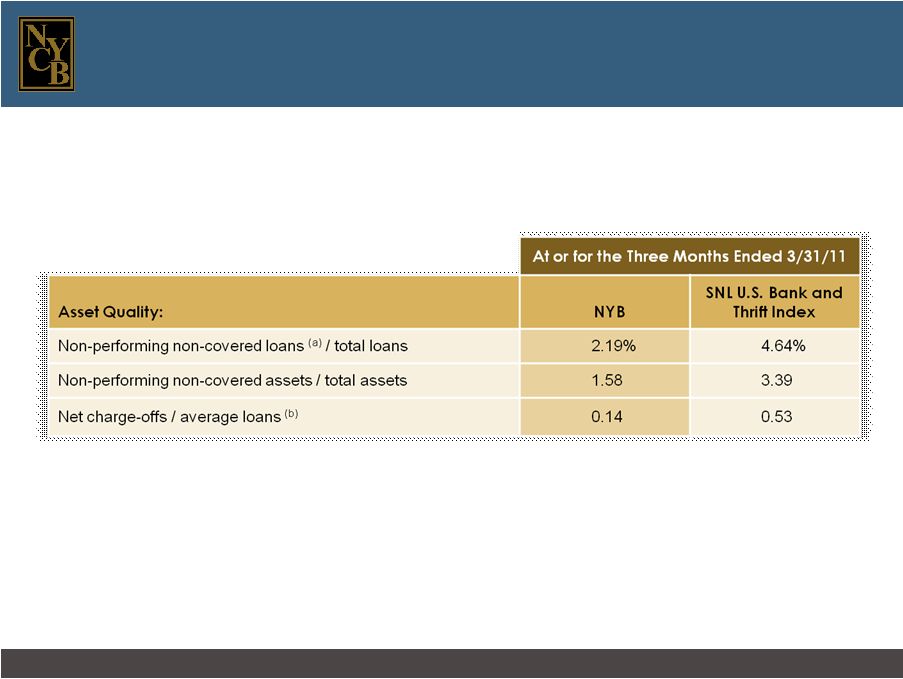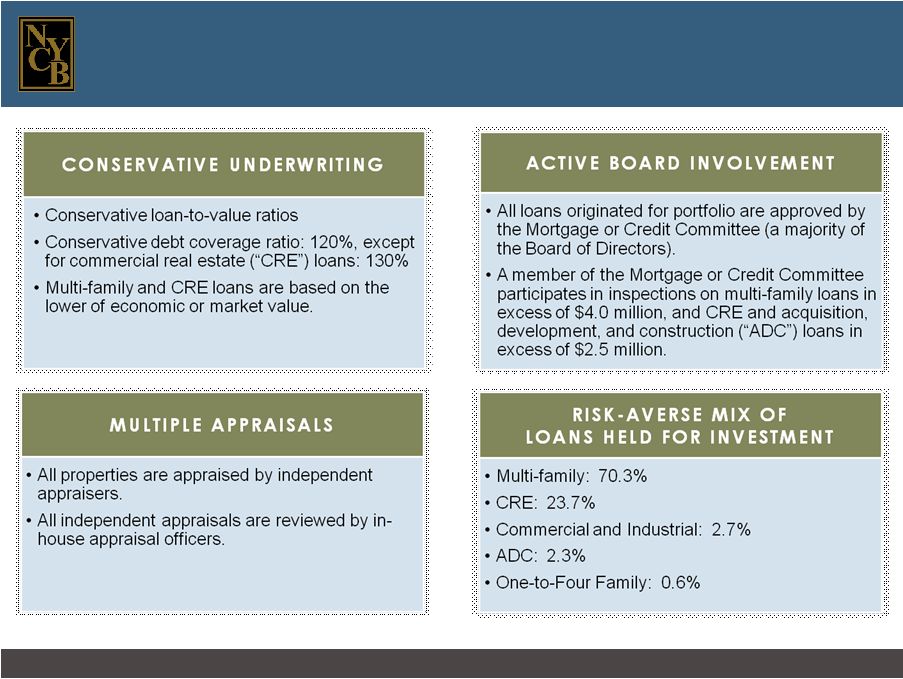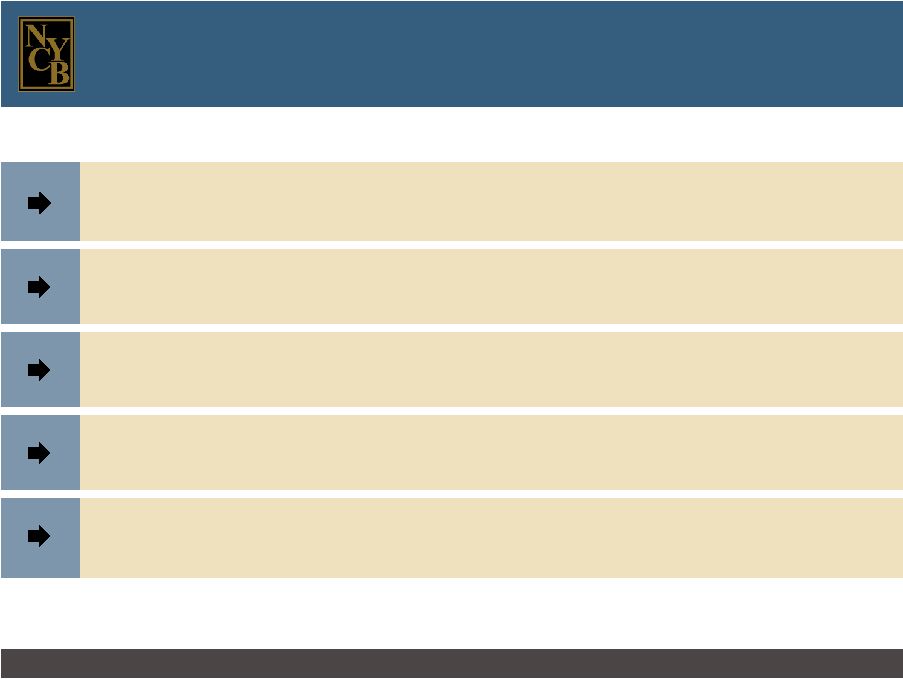Attached files
| file | filename |
|---|---|
| 8-K - FORM 8-K - NEW YORK COMMUNITY BANCORP INC | d8k.htm |
 First
Quarter 2011 Investor Presentation
*
*
*
*
*
*
*
Exhibit 99.1 |
 New
York Community Bancorp, Inc. Page 2
Forward-looking Statements and Associated Risk
Factors
This presentation, like many written and oral communications presented by New York Community Bancorp,
Inc. and our authorized officers, may contain certain forward-looking statements regarding
our prospective performance and strategies within the meaning of Section 27A of the Securities Act of 1933, as amended, and Section 21E of the Securities
Exchange Act of 1934, as amended. We intend such forward-looking statements to be covered by the
safe harbor provisions for forward-looking statements contained in the Private Securities
Litigation Reform Act of 1995, and are including this statement for purposes of said safe harbor provisions.
Forward-looking statements, which are based on certain assumptions and describe future plans,
strategies, and expectations of the Company, are generally identified by use of the words
“anticipate,” “believe,” “estimate,” “expect,” “intend,” “plan,” “project,” “seek,” “strive,” “try,” or future or conditional verbs such as
“will,” “would,” “should,” “could,” “may,” or similar
expressions. Our ability to predict results or the actual effects of our plans or strategies is
inherently uncertain. Accordingly, actual results may differ materially from anticipated results.
There are a number of factors, many of which are beyond our control, that could cause actual
conditions, events, or results to differ significantly from those described in the forward-
looking statements. These factors include, but are not limited to: general economic conditions, either
nationally or in some or all of the areas in which we and our customers conduct our respective
businesses; conditions in the securities markets and real estate markets or the banking industry; changes in interest rates, which may affect our net income, prepayment
penalty income, and other future cash flows, or the market value of our assets, including our
investment securities; changes in deposit flows and wholesale borrowing facilities; changes in
the demand for deposit, loan, and investment products and other financial services in the markets we serve; changes in our credit ratings or in our ability to access the
capital markets; changes in our customer base or in the financial or operating performances of our
customers’ businesses; changes in real estate values, which could impact the quality of
the assets securing the loans in our portfolio; changes in the quality or composition of our loan or securities portfolios; changes in competitive pressures among financial
institutions or from non-financial institutions; the ability to successfully integrate any assets,
liabilities, customers, systems, and management personnel we may acquire into our operations,
and our ability to realize related revenue synergies and cost savings within expected time frames; our use of derivatives to mitigate our interest rate exposure; our ability to
retain key members of management; our timely development of new lines of business and competitive
products or services in a changing environment, and the acceptance of such products or services
by our customers; any breach in performance by the Community Bank under our loss sharing agreements with the FDIC; any interruption or breach of security
resulting in failures or disruptions in customer account management, general ledger, deposit, loan, or
other systems; any interruption in customer service due to circumstances beyond our control;
potential exposure to unknown or contingent liabilities of companies we have acquired or target for acquisition; the outcome of pending or threatened litigation, or of other
matters before regulatory agencies, whether currently existing or commencing in the future; changes in
our estimates of future reserves based upon the periodic review thereof under relevant
regulatory and accounting requirements; changes in our capital management policies, including those regarding business combinations, dividends, and share repurchases,
among others; changes in legislation, regulation, policies, or administrative practices, whether by
judicial, governmental, or legislative action, including, but not limited to, the impact of the
Dodd-Frank Wall Street Reform and Consumer Protection Act, and other changes pertaining to banking, securities, taxation, rent regulation and housing, environmental protection,
and insurance, and the ability to comply with such changes in a timely manner; additional FDIC special
assessments or required assessment prepayments; changes in accounting principles, policies,
practices, or guidelines; environmental conditions that exist or may exist on properties owned by, leased by, or mortgaged to the Company; operational issues
stemming from, and/or capital spending necessitated by, the potential need to adapt to industry
changes in information technology systems, on which we are highly dependent; the ability to
keep pace with, and implement on a timely basis, technological changes; changes in the monetary and fiscal policies of the U.S. Government, including policies of the U.S.
Department of the Treasury and the Board of Governors of the Federal Reserve System; war or terrorist
activities; and other economic, competitive, governmental, regulatory, and
Safe
Harbor
Provisions
of
the
Private
Securities
Litigation
Reform
Act
of
1995
geopolitical factors affecting our operations, pricing, and services. For a discussion of
these and other risks that may cause actual results to differ from expectations, please refer to our Annual Report on Form 10-K for the year ended December 31,
2010, including the section entitled “Risk Factors,” on file with the U.S. Securities and
Exchange Commission (the “SEC”). In addition, it should be noted that we routinely evaluate opportunities to expand through acquisition
and frequently conduct due diligence activities in connection with such opportunities. As a
result, acquisition discussions and, in some cases, negotiations, may take place at any time, and acquisitions involving cash, debt, or equity securities may occur.
Furthermore, the timing and occurrence or non-occurrence of events may be subject to circumstances
beyond our control.
Readers are cautioned not to place undue reliance on the forward-looking statements contained
herein, which speak only as of the date of this presentation. Except as required by applicable
law or regulation, we undertake no obligation to update these forward-looking statements to reflect events or circumstances that occur after the date on which such
statements were made. |
 New
York Community Bancorp, Inc. Page 3
New York Community Bancorp ranks among the top 25
bank holding companies in the United States.
Note: Except as otherwise indicated, all industry data was provided by SNL
Financial as of 4/28/11. |
 New
York Community Bancorp, Inc. Page 4
Largely reflecting our acquisition strategy, we
currently have 276 locations in five states.
Metro New York
157 Branches
Ohio
28 Branches
New Jersey
52 Branches
Florida
25 Branches
Arizona
14 Branches |
 New
York Community Bancorp, Inc. Page 5
We have a meaningful share of deposits in several
of the markets we serve. |
 1st
Quarter 2011 Performance Highlights
*
*
*
*
*
*
*
*
**************** |
 New
York Community Bancorp, Inc. Page 7
Our 1Q 2011 performance reflected solid earnings.
(a)
Please see page 36 for a reconciliation of our GAAP and operating earnings.
(b)
Please see page 39 for a reconciliation of our GAAP and non-GAAP capital
measures. (c)
Please see page 36 for a reconciliation of our GAAP and operating efficiency
ratios. (dollars in thousands, except per share data)
|
 New
York Community Bancorp, Inc. Page 8
We also continued to strengthen our balance sheet. |
 New
York Community Bancorp, Inc. Page 9
Our asset quality measures continue to compare
favorably with those of our industry as a whole. (a)
Non-performing loans are defined as non-accrual loans and loans 90 days or
more past due but still accruing interest. (b)
Non-annualized |
 New
York Community Bancorp, Inc. Page 10
(a)
Please see page 38 for a reconciliation of our GAAP and non-GAAP capital
measures. Growth has been supported by our earnings.
Our dividend has been a significant component of our total return to shareholders
since our first year of public life.
In April 2011, we declared our 29th consecutive quarterly cash dividend of $0.25 per
share. |
 A
Successful Business Model *
*
*
*
*
*
*
*
*********
******* |
 New
York Community Bancorp, Inc. Page 12
Our business model has consistently focused on
building value while building the Company.
(a)
Please see page 36 for a reconciliation of our GAAP and operating efficiency
ratios. |
 Growth through Acquisitions
*
*
*
*
*
*
*
*
*********
******* |
 New
York Community Bancorp, Inc. Page 14
We have completed 10 acquisitions since 2000.
Note:
The number of branches indicated reflects the number of branches in our current
franchise that stemmed from each transaction. Transaction Type:
Savings Bank
Commercial Bank
Branch
FDIC |
 New
York Community Bancorp, Inc. Page 15
Our deposit growth has been largely acquisition-
driven. |
 New
York Community Bancorp, Inc. Page 16
(a)
Originations of loans held for sale totaled $888.5 million in 2009, $10.8 billion
in 2010, and $1.5 billion in 1Q 2011. Acquisitions have provided much of the
funding for the organic growth of our loan portfolio.
|
 New
York Community Bancorp, Inc. Page 17
We have capitalized on opportunities for revenue
growth stemming from our acquisitions.
HAVN
We enhanced our revenue
stream by selling third-party
investment products
(insurance, mutual funds,
and annuities) through CFS
Investments,
generating
revenues of $90.2 million
since 2000.
We complemented our
traditional branch network
with a network of in-store
branches that enhanced our
customer service and
efficiency.
RCBK
We acquired an investment
management firm, Peter B.
Cannell & Co., Inc., which
has generated revenues of
$108.0 million since 2001.
LICB
We established a commercial
bank subsidiary, New York
Commercial Bank. |
  New York
Community Bancorp, Inc. Page 18
Our mortgage banking platform is a leading aggregator of
agency-conforming one-to-four family residential loans.
(in millions)
Funded 1-4 Family
Loan Production |
   Multi-Family Loan Production
*
*
*
*
*
*
*
*
***********
***** |
 New
York Community Bancorp, Inc. Page 20
For more than 40 years, we have been a leading producer of
multi-family loans on apartment buildings in New York City,
most of which feature below-market rents. |
 New
York Community Bancorp, Inc. Page 21
Our focus on multi-family lending on rent-regulated buildings
has enabled us to distinguish ourselves from our industry peers.
64.0% of the rental housing units in New York City are subject to rent regulation
and therefore feature below-market rents.
(a)
Rent-regulated buildings are more likely to retain their tenants and therefore
their revenue stream in a downward credit cycle.
Our focus on multi-family lending in this niche market has contributed to our
record of asset quality.
Multi-family loans are less costly to produce and service than other types of
loans, and therefore contribute to our superior efficiency.
(a)
Source: New York City Rent Guidelines Board 2010 Housing Supply Report
|
 New
York Community Bancorp, Inc. Page 22
(in millions)
Multi-family Loan Portfolio
Multi-family loans have grown at a CAGR of 25.2%
since 12/31/99. |
 New
York Community Bancorp, Inc. Page 23
(in millions)
Commercial Real Estate Loan Portfolio
Our commercial real estate loans feature the same
structure as our multi-family loans. |
 Asset
Quality *
*
*
*
*
*
*
*
**************** |
 New
York Community Bancorp, Inc. Page 25
Both historically and currently, we have been
distinguished by our low level of net charge-offs.
Net Charge-Offs / Average Loans
(a)
(a)
(a) Non-annualized |
 New
York Community Bancorp, Inc. Page 26
The quality of our loan portfolio continues to exceed
that of our industry, as it has in the past.
(a)
Non-performing loans are defined as non-accrual loans and loans 90 days or
more past due but still accruing interest. (b)
Non-performing loans exclude covered loans.
Non-Performing Loans
(a)
/ Total Loans |
 New
York Community Bancorp, Inc. Page 27
Historically and currently, few of our non-performing
loans have resulted in charge-offs.
(a)
Non-performing loans are defined as non-accrual loans and loans 90 days or
more past due but still accruing interest. (b)
Non-performing loans exclude covered loans.
(c)
Non-annualized |
 New
York Community Bancorp, Inc. Page 28
The quality of our assets reflects the nature of our multi-family
lending niche and our strong underwriting standards. |
  New York
Community Bancorp, Inc. Page 29
All the loans acquired in the AmTrust and Desert Hills transactions are
covered by FDIC loss sharing agreements, thus mitigating credit risk.
(in millions)
Total covered assets: $4.2 billion
Covered Assets
3/31/11
1-4 Family
$3,735.1
Other Loans
$406.2
Percent of total assets: 10.3%
OREO
$81.2 |
   Efficiency
*
*
*
*
*
*
*
*
**************** |
 New
York Community Bancorp, Inc. Page 31
Our operating efficiency ratio was 39.59%
in 1Q 2011, well below
the SNL U.S. Bank and Thrift Index efficiency ratio of 63.85%.
(a)
Please see pages 36 and 37 for a reconciliation of our GAAP and operating
efficiency ratios. |
 New
York Community Bancorp, Inc. Page 32
Our efficiency is driven by several factors.
Franchise expansion has largely stemmed from mergers and acquisitions; we generally
do not engage in de novo branch development.
Multi-family and commercial real estate lending are both broker-driven, with
the borrower
paying
fees
to
the
mortgage
brokerage
firm,
rather
than
the
bank.
Products and services are typically developed by third-party providers and the
sale of these products generates additional revenues.
42 of our branches are located in-store, where rental space is less costly,
enabling us to supplement
the
service
provided
by
our
traditional
branches
more
efficiently.
We acquire our deposits primarily through earnings-accretive acquisitions rather
than by paying above-market rates. |
 Total
Return on Investment *
*
*
*
*
*
*
*
**********
****** |
 New
York Community Bancorp, Inc. Page 34
We are committed to building value for our
investors.
TOTAL RETURN ON INVESTMENT
(a)
Bloomberg
As
a
result
of
nine
stock
splits
in
a
span
of
10
years,
our
charter
shareholders
have
2,700
shares of NYB stock for each 100 shares originally purchased.
|
 New
York Community Bancorp, Inc. Page 35
4/28/2011
For More Information |
 New
York Community Bancorp, Inc. Page 36
For the Three Months Ended
March 31, 2011
(dollars in thousands)
GAAP
Operating
Total non-interest income and net interest income
$361,862
$361,862
Adjustments:
Gain on sales of securities
--
(9,992)
Adjusted total non-interest income and net interest income
$361,862
$351,870
Operating expenses
$139,317
$139,317
Efficiency ratio
38.50%
39.59%
Reconciliation of GAAP and Operating Earnings and
Efficiency Ratios
The following table presents reconciliations of the Company’s GAAP and
operating efficiency ratios for the three months ended March 31, 2011. The
following table presents reconciliations of the Company’s GAAP and operating earnings for the three months ended March 31, 2011.
(in thousands, except per share data)
For the Three Months Ended
March 31, 2011
GAAP Earnings
$123,176
Adjustments to GAAP earnings:
Gain on sales of securities
(9,992)
Income tax effect
4,016
Operating earnings
$117,200
Diluted GAAP Earnings per Share
$ 0.28
Adjustments to diluted GAAP earnings per share:
Gain on sales of securities
(0.01)
Diluted operating earnings per share
$ 0.27 |
 New
York Community Bancorp, Inc. Page 37
Reconciliation of GAAP and Operating Efficiency
Ratios
The following table presents reconciliations of the Company’s GAAP and
operating efficiency ratios for the years ended December 31, 2006, 2007,
2008, 2009, and 2010.
For the Years Ended December 31,
2010
2009
2008
2007
2006
(dollars in thousands)
GAAP
Operating
GAAP
Operating
GAAP
Operating
GAAP
Operating
GAAP
Operating
Total net interest income and non-interest income
$1,517,886
$1,517,886
$1,062,964
$1,062,964
$691,024
$691,024
$727,622
$727,622
$650,556
$650,556
Adjustments:
Gain on debt repurchases/exchange
--
(2,441)
--
(10,054)
--
--
--
--
--
--
Gain on business acquisitions
--
(2,883)
--
(139,607)
--
--
--
--
--
--
Gain on termination of servicing hedge
--
--
--
(3,078)
--
--
--
--
--
--
Visa-related gain
--
--
--
--
--
(1,647)
--
--
--
--
Net gain on sales of securities
--
(22,438)
--
--
--
--
--
(1,888)
--
--
Loss on mark-to-market of interest rate swaps
--
--
--
--
--
--
--
--
--
6,071
(Gain) loss on debt redemption
--
--
--
--
--
(16,962)
--
1,848
--
1,859
Loss on other-than-temporary impairment of
securities
--
--
--
96,533
--
104,317
--
56,958
--
--
Balance sheet repositioning charge
--
--
--
--
--
39,647
--
--
--
--
Gain on sale of bank-owned property / branches
--
--
--
--
--
--
--
(64,879)
--
--
Adjusted total net interest income and
non-interest
income
$1,517,886
$1,490,124
$1,062,964
$1,006,758
$691,024
$816,379
$727,622
$719,661
$650,556
$658,486
Operating expenses
$546,246
$546,246
$384,003
$384,003
$320,818
$320,818
$299,575
$299,575
$256,362
$256,362
Adjustments:
FDIC special assessment
--
--
--
(14,753)
--
--
--
--
--
--
Acquisition-related costs
--
(11,545)
--
(5,185)
--
--
--
--
--
--
Merger-related charge
--
--
--
--
--
--
--
(2,245)
--
(5,744)
VISA litigation charge
--
--
--
--
--
(3,365)
--
(1,000)
--
--
Retirement charge
--
--
--
--
--
--
--
--
--
(3,072)
Adjusted operating expenses
$546,246
$534,701
$384,003
$364,065
$320,818
$317,453
$299,575
$296,330
$256,362
$247,546
Efficiency ratio
35.99%
35.88%
36.13%
36.16%
46.43%
38.89%
41.17%
41.18%
39.41%
37.59% |
 New
York Community Bancorp, Inc. Page 38
Reconciliation of GAAP and Non-GAAP Capital
Measures
March 31,
December 31,
March 31,
(dollars in thousands)
2011
2010
2010
Total stockholders’
equity
$ 5,540,586
$ 5,526,220
$ 5,413,461
Less: Goodwill
(2,436,159)
(2,436,159)
(2,436,401)
Core deposit intangibles
(70,349)
(77,734)
(101,108)
Tangible stockholders’
equity
$ 3,034,078
$ 3,012,327
$ 2,875,952
Total assets
$41,046,944
$41,190,689
$42,430,737
Less: Goodwill
(2,436,159)
(2,436,159)
(2,436,401)
Core deposit intangibles
(70,349)
(77,734)
(101,108)
Tangible assets
$38,540,436
$38,676,796
$39,893,228
Stockholders’
equity to total assets
13.50%
13.42%
12.76%
Tangible stockholders’
equity to tangible assets
7.87%
7.79%
7.21%
Tangible stockholders’
equity
$ 3,034,078
$3,012,327
$2,875,952
Accumulated other comprehensive loss, net of tax
50,521
45,695
53,852
Adjusted tangible stockholders’
equity
$3,084,599
$3,058,022
$2,929,804
Tangible assets
$38,540,436
$38,676,796
$39,893,228
Accumulated other comprehensive loss, net of tax
50,521
45,695
53,852
Adjusted tangible assets
$38,590,957
$38,722,491
$39,947,080
Adjusted tangible stockholders’
equity to adjusted tangible assets
7.99%
7.90%
7.33%
The following table presents reconciliations of our GAAP and non-GAAP capital
measures at March 31, 2010, December 31, 2010, and March 31, 2011. |
 New
York Community Bancorp, Inc. Page 39
Reconciliation of GAAP and Non-GAAP Capital
Measures
(dollars in thousands)
For the Three
Months Ended
March 31, 2011
Average Stockholders’
Equity
$ 5,511,970
Less: Average goodwill and core deposit intangibles
(2,511,349)
Average tangible stockholders’
equity
$ 3,000,621
Average Assets
$40,713,044
Less: Average goodwill and core deposit intangibles
(2,511,349)
Average tangible assets
$38,201,695
Net Income
$123,176
Add back: Amortization of core deposit intangibles, net of tax
4,431
Adjusted net income
$127,607
Operating Income
$117,200
Add back: Amortization of core deposit intangibles, net of tax
4,431
Adjusted operating income
$121,631
Return on average assets
1.21%
Operating return on average assets
1.15
Return on average tangible assets
1.34
Operating return on average tangible assets
1.27
Return on average stockholders’
equity
8.94
Operating return on average stockholders’
equity
8.51
Return on average tangible stockholders’
equity
17.01
Operating return on average tangible stockholders’
equity
16.21
The following table presents additional reconciliations of our GAAP and
non-GAAP capital measures at March 31, 2011. |
